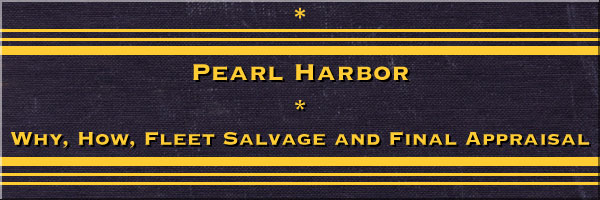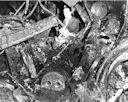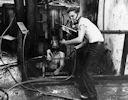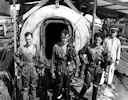
CHAPTER XIV
Conditions Which Prevailed Or Were Encountered In Salvage
1. LACK OF MATERIAL
Pearl Harbor was noted for shortages. This was a fact of life in a comparatively new fleet base 2000 miles from home. It has already been pointed out that there was a great shortage of oil, of oil tankers, of service craft, and countless other things to support a fleet which was ever growing.
The treacherous Japanese attack on a Sunday morning accentuated these shortages. If adequate pumping facilities had been at hand some of the ships would not have been sunk. If better fire protection had been available many of the fires which caused so much damage could have been extinguished.
The salvage effort would have been made much easier with ample supplies near at hand. The shortage of lumber and fastenings was acute; the shortage of manpower, especially electric welders and carpenters was keenly felt. All civilian mechanics and engineers were in short supply at the Navy Yard and in Honolulu.
The right kind of pumps arrived late. These were the deep-well pumps which were used effectively on the later battleships, especially West Virginia and Oklahoma. They varied in size up to 10 inches, and for Oklahoma as big as 18 inches and even 20 inches. They were driven by electric or diesel power, and were essential in ridding a badly wounded ship of incoming water.
2. FIRE HAZARDS ON THE SHIPS THEMSELVES
The European War taught the fleet much regarding fire hazards and floatability. Before the surprise air attack many fire hazards had been removed from combat ships. There is a tendency on the part of all personnel to be
--273--
"pack rats," to have at hand anything that may sometime be required. This inclination of human nature resulted in stowing away an excess of rubber sheeting, paints, canvas, oakum, linoleum, and so on. These were removed and greatly reduced the fire hazard and improved the floatability.
During the war all linoleum was taken off the ships and all oil paints were put ashore. Paint was chipped off down to bare metal and later was replaced with latex or water paints. These have satisfactory preservative qualities and are better than oil paints in resisting fire and high temperature.
Of all shortages, limited ordnance material presented the worst problem. Except for anti-aircraft guns on ships there was little defense of Pearl Harbor and the various airfields. No temporary batteries were installed, and 30 caliber machine guns were the main ones ready at the air bases. The
3. SALVAGE OF ORDNANCE MATERIAL

USN NR&L (MOD) 39774
Adjusting discharge hose from submersible pump in 14-inch magazine spaces during refloating operations in Oklahoma.
--274--
batteries of ships were restricted in their zones of action, and Sunday morning at "colors" was a time of maximum unreadiness.
Thus it was that one of the prime jobs was to build up the anti-aircraft defense. This was done quickly by transferring the batteries and their ammunition from disabled ships to points of vantage around the Navy Yard and air stations. Much of the removal work from ships was done by divers, and though this slowed up the transfer it was not long before Pearl Harbor had a tolerable anti-aircraft defense.
The Ordnance Section gave attention to other salvage as well as antiaircraft batteries and ammunition. They worked assiduously in saving range finders, directors, small arms, and fine ordnance instruments from various sunken ships. This material required care and preservation in most cases, and the material was soon ready for use against the enemy.
4. ELECTRICAL EQUIPMENT
When it was ascertained from the experience on Nevada that total submergence in sea water permitted electrical equipment to be used again, there was much surprise in the fleet. Of course, proper steps for care and preservation had to be taken. Even the most delicate instruments, such as ammeters and wattmeters, were usable if properly cleaned and preserved before exposure to the air. The same pertained to cables and motors. If properly dried out and cleaned thoroughly they were usable. However, vital electric cables and motors were replaced.
It was learned that low humidity helped re-use. The humidity near the ocean meant that the equipment would ultimately fail. To avoid this, some of it was sent as far away as Denver. There it stood every test but proved questionable when returned to the seacoast. It should be clearly understood that here we are dealing with electric gear that has been submerged in sea water only a comparatively short time and has not been subjected to the tidal currents of the sea.
It was realized that no chance should be taken with respect to high potential lines and equipment. Accordingly, all such electrical gear was replaced as work progressed. No difficulty was experienced with either high potential or ordinary electrical equipment later in the war.
Due to the importance of this subject, additional detail is included in Appendix B.
--275--
5. JAPANESE TORPEDOES AND BOMBS
Salvage experience proved that a fair proportion of Japanese bombs and torpedoes failed to explode. This was especially true of the 800 kilogram bombs dropped from about 10,000 feet. These were made over from armor-piercing shells of 14 or 15-inch size, and were intended to pierce the armored decks of battleships, aircraft carriers, or cruisers. They had an explosive charge of about 430 pounds. On the other hand, the 250 kilogram bombs used by dive-bombers were very effective and were frequently mistaken for incendiary bombs by our forces. The explosive charge of these bombs was about 135 pounds.
The torpedoes used by the Japanese seem to cover a variety of explosive charges. According to the Japanese story given after the surrender, they all were of the "Long Tom" variety which were so effective in the Guadalcanal Campaign. These use oxygen in lieu of air. which is safer, and carry

USN NR&L (MOD) 39775
Removal of dud bomb found in West Virginia.
--276--
an explosive charge of about 1000 to 1200 pounds. The American counterpart has an explosive charge of only 500 to 600 pounds.
It is worth noting that American torpedoes fired by our submarines early in the war sometimes failed to explode although they could be heard making contact with enemy ships. This deficiency was rectified after we developed a more reliable exploder.
Likewise, our close range anti-aircraft batteries had limitations. The American 1.1 inch in quadruple mounts seemed to be effective but frequent jamming curtailed efficiency. Our Bureau of Ordnance was in the process of getting from Sweden the 40-millimeter Bofors gun which could be mounted in twos or fours, and the 20-millimeter Oerlikon gun from Switzerland. These were used in great numbers on our ships from 1942 on.
There was much strafing by Japanese airplanes. Aside from causing a few casualties, this was ineffective. It has a value when it deters personnel from doing what should be done, but the evidence is clear that such things were done despite the strafing. So far as the ships were concerned, it is evident that strafing causes no real damage. At times, however, strafing is highly effective against personnel.
6. DIVING EXPERIENCE
Without competent divers the salvage work would have been impossible. Credit has been given to the various divers in each operation, but their outstanding efficiency deserves mention again. The supervision of the divers was excellent. Lieutenant Haynes was a stickler for safety, as were his assistants. The divers from the Salvage Division, the Navy Yard, Ortolan, Widgeon, and elsewhere made about 4,000 dives totaling some 16,000 hours underwater without a single serious casualty. The contractor had one casualty. The total of the contractor and the Navy was about 5,000 dives with about 20,000 hours underwater. Considering the difficulty, hazard, and importance of the work, this is a remarkable record.
7. DEADLY GAS ENCOUNTERED ON MOST SHIPS
The prevalence of hydrogen sulfide in Nevada and other ships was indeed a new phenomenon. While we usually think this gas has the smell of rotten
--277--
eggs; the gas when absorbed in water at high pressure has no smell at all. At higher concentrations it is undetectable because it tends to paralyze the sense of smell. There were other gases encountered but none so deadly and widespread. Lack of oxygen in the spaces unwatered was commonplace.
Hydrogen sulfide is formed by polluted water working on paper products. It was found in compartments of every large ship, sometimes in lethal doses. After the Nevada incident, in which two men were lost, great care was taken with regard to sending men into spaces recently unwatered. Tests were taken of the air and frequent inspections made by experts of this industrial hazard. Each man wore some litmus paper on his tank suit to reveal the presence of gas.
Ample ventilation put fresh air into each compartment to insure the dilution of deadly gases and to provide oxygen into spaces which were deficient. When necessary to send men into untested areas they were equipped with gas masks or rescue breathing apparatus. Divers were prevented from using only face masks in waters which showed heavy pollution.

USN NR&L (MOD) 39776
Divers emerging from gas-filled compartments
--278--

USN NR&L (MOD) 39777
Ventilation for work in Oklahoma blister
In view of the importance of this subject, Appendix C is added for the information of those engaged in such work.
8. GASOLINE EXPLOSIONS
The gasoline vapor explosion on California taught an important lesson. Despite ventilation which was deemed adequate, the accident occurred. It was a serious explosion too, and would have caused casualties to anyone in the vicinity at the time. As it was, the structure was ruptured and an efficient hull patch rendered useless near the time for drydocking. Luckily it happened in a location which permitted isolation of the flooded spaces. This allowed drydocking on schedule.
Advantage was taken of this lesson in future salvage work. On West Virginia and other ships, the gasoline tanks were thoroughly emptied and gasoline vapors eliminated.
When a steam blanket cannot be used over oil, it is mandatory that divers engaged in welding or cutting drill holes somewhat higher than where they are working to allow oil vapors to escape. This method was
--279--
used on Oklahoma, and though some small explosions occurred none were serious.
9. ELECTRIC-DRIVE BATTLESHIPS
When two electric-drive battleships were among the casualties of the air raid, it was at first assumed that four or five years would be required to rehabilitate the propulsion machinery of California and West Virginia. But necessity is the mother of invention and the mainspring of action.
Details are given in the account of California salvage of the rewinding of alternators and motors and the restocking of their iron elements. Suffice it to say here that California was on her way to Bremerton on 10 October 1942 and West Virginia followed shortly after. Both traveled under their own power and emerged from the Bremerton Navy Yard as modern ships to participate fully in the war against Japan. For more information on reconditioning these electric-drive ships see Appendix D.
10. CLASSIFIED CORRESPONDENCE AND PERSONAL PROPERTY
Great care was always used to insure the proper handling of classified correspondence and papers. This included personal property which was retrieved from lockers of men who were lost or who had departed on other ships. Ordinarily these papers or valuables were delivered to the Commanding Officer or to whomever he might designate as the proper officer to receive them. Personal property removed from lockers was tagged for identification and delivered in due course to owners or relatives.
11. REMOVAL OF HUMAN BODIES
Some of the ships had large numbers of human bodies in various compartments. A scheme was developed for handling these without the knowledge of the men who comprised the working parties. Two or three feet of water were left in each compartment so that the bodies could be floated into canvas bags. The bags were tightly tied and transported to the Naval
--280--
Hospital for proper identification and burial. The method was very effective and was undisturbing to the salvage crew.
12. CLEANING OF COMPARTMENTS
The cleaning of compartments of unwatered ships was a beggarly job. There was always a shortage of manpower, as the original crews had largely gone to other duty. Trained men for the fleet were in short supply; even recruits were in great demand, as were naval reservists who had some training in their specialties. The men for salvage work came mostly from the Receiving Ship or from vessels in ordinary. These men had numerous assignments and it was only near drydocking time that the total reached as many as 400 to 500 men. The Salvage Officer requested 800 men near the end of a job, but this figure was never reached.
Each man of the cleaning crew had a tank suit and knee-high rubber boots for especially dirty work. The suits which became oil soaked were turned in for a freshly laundered suit. Boots were cleaned by the wearer. Only selected men were given gas masks for entering spaces that had not yet been adequately ventilated and lighted. They had litmus paper attached to their suits to show presence of toxic gases
The cleaning crew found material and equipment of all sorts strewn about, and oil everywhere. Their first job was the removal of wreckage. The next was washing down by a high pressure hose. Both sea water and fresh water were tried, but fresh water did a better job. This was followed by a caustic solution which cut the oil coating. Then fresh water would do a clean and finished job.
One of the chores of the cleaning gang was to remove ammunition from turrets and magazines, and to take off cases of canned goods and other stores. All of the latter was scrapped in accordance with the recommendation of the representative from the Department of Agriculture. In a region of food shortage it was hard to see unbulged canned food dumped at sea, but that was the order of competent authority.
13. WORK PERFORMED BY THE NAVY YARD
Too much credit cannot be given to the Navy Yard, Pearl Harbor, for its part in ship salvage and rehabilitation. There was a close tie between the Salvage Division and the Navy Yard. Consequently the Salvage Division
--281--
was given up-to-date information from Design and Planning with respect to stability and floatability of any ship under varying conditions. True enough there was difference of opinion at times, but these differences were always worked out between the parties involved.
The performance of the Navy Yard when the raised ships entered drydock left nothing to be desired. In spite of the heavy workload of supporting a fleet at war, the Navy Yard was always available to repair, on a permanent or temporary basis, the ships presented to it. This was done despite a growing shortage of manpower in several of the engineering and mechanical ratings. In due time this shortage was overcome by importing workers from the mainland Navy Yards and shipbuilding companies. It might be mentioned that all of these men were not desirable, and a keen eye was necessary to detect professional gamblers and other similar characters.
Special mention should be made of the Navy Yard's work in rehabilitating electric motors and electric-drive battleships. Through the Yard various contracts were made for handling motors and other electrical gear. These contracts ranged from Honolulu to Oakland. Full cooperation with the General Electric men and the Navy Yard brought the electric-drive battleships to the point where they could go to Bremerton under their own power and later join the fleet which defeated Japan.
The services rendered by the Navy Yard are too numerous to mention. Among others, it furnished scarce scrap materials to manufacturers on the mainland. It gained the thanks of government officials in Washington who oversaw such work. The Navy Yard prided itself in sending large amounts of steel, rubber, electric cables, brass, and aluminum to the mainland.
The Japanese could not stop the flow of scrap materials to the mainland throughout the war. Neither were the Japanese effective in intercepting ships carrying personnel or other material to or from Pearl Harbor; nor were they effective against the crippled ships which regularly crossed the ocean on the way to Bremerton or to Mare Island or other California ports. Japanese submarines proved to be a complete loss.
14. USE OF SUNKEN OR DAMAGED SHIPS IN THE WAR EFFORT
The enemy achieved much of his goal in the perfidious air raid of 7 December 1941. Although only 19 ships of the almost 100 that occupied berths
--282 --
at Pearl Harbor were sunk or damaged, an important part of the fleet was immobilized for many months.
The shortage of ships prevented decisive action against a superior foe. It was only after new ships joined the fleet from building yards or the Atlantic that offensive warfare could be pursued in earnest.
In a war which lasted nearly four years all nineteen of the Pearl Harbor victims, except Oklahoma, Arizona, and Utah, saw action against the Japanese Navy, This included vessels which had been given up by the Secretary of the Navy as lost, or enumerated by the Japanese as destroyed at Pearl Harbor. The marvel of salvage surprised not only the Japanese but also our own forces.
As described, many of the salvaged ships performed wonders during the war. Their strength augmented the fleet, and it was this overall strength that ultimately won the unconditional surrender of Japan. We learned that sunken or damaged ships can be put to work again and with greatly increased potential.
It should be mentioned that the battleships at Pearl Harbor were ill prepared for survival. They were not in a battle condition. As a comparison, consider the German battleship Bismarck, or the two new Japanese 64,000 ton battleships which were put into service in 1941 and 1942. The metacentric height of each ship was about ten feet or more. These ships were in action with all closures made, and with excellent damage repair facilities. They were finally sunk, but not until each of them had taken approximately 10 torpedoes and from 10 to 20 bombs.
15. SPIRIT OF THE SALVAGE CREW
Enough cannot be said in praise of the salvage crew. They worked hard and earnestly. They soon saw that the results of their efforts exceeded the fondest hopes of their supporters and they were urged on by their successive achievements.
Much has been said of the men who contributed most to the salvage of each ship. Praise has been given to the Navy Yard and to the Pacific Bridge Company, but little has been said of the men in the Central Office. They consistently did much to keep the gears meshed and turning. Without them the Salvage Organization would not have functioned smoothly.
All projects were pursued to a happy conclusion. There was no bickering
--283--
or an "I told you so" attitude. There was a meeting of the minds in all the jobs in which the Salvage Division was engaged. There was never a lack of confidence. Instead, there was a feeling of assurance in the outcome of each job. This consistent oneness of purpose can best be explained by the operation of the One Mind which governs all things well.

USN NR&L (MOD) 39778
Divers standing in front of decompression chamber.
I made recommendations to the Commandant of the Navy Yard regarding the medals which a grateful Nation should bestow upon its benefactors engaged in salvage work. Before departing for the South Pacific I was recommended for the Navy's Distinguished Service Medal by the Forces Afloat, and this was presented to me by Admiral Nimitz on the deck of the aircraft carrier Enterprise. At that time about a dozen other medals were presented for deeds of valor. Admiral Nimitz read the citation for the work performed by the Salvage Organization and ended by adding, "for being an undying optimist". The Medal was accepted by me in the name of the organization which I had the honor to head.
--284--
Contents
Previous Chapter (13) * Next Chapter (15)